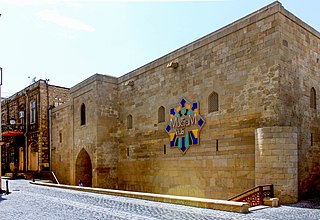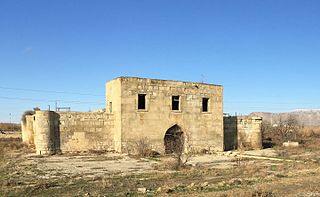
A caravanserai was a roadside inn where travelers (caravaners) could rest and recover from the day's journey. Caravanserais supported the flow of commerce, information and people across the network of trade routes covering Asia, North Africa and Southeast Europe, most notably the Silk Road. Often located along rural roads in the countryside, urban versions of caravanserais were also historically common in cities throughout the Islamic world, and were often called other names such as khan, wikala, or funduq.

The Ateshgah of Baku, Azerbaijani: Atəşgah), often called the "Fire Temple of Baku", is a castle-like religious temple in Surakhany town, a suburb in Baku, Azerbaijan.

The Baku Governorate, known before 1859 as the Shemakha Governorate, was a province (guberniya) of the Caucasus Viceroyalty of the Russian Empire, with its center in the booming metropolis and Caspian Sea port of Baku. Area (1897): 34,400 sq. versts, population (1897): 789,659. The Baku Governorate bordered Persia to the south, the Elizavetpol Governorate to the west, the Dagestan Oblast to the north, and the Baku gradonachalstvo to the east on the Absheron Peninsula.

Old City or Inner City is the historical core of Baku, the capital of Azerbaijan. The Old City is the most ancient part of Baku, which is surrounded by walls. In 2007, the Old City had a population of about 3,000 people. In December 2000, the Old City of Baku, including the Palace of the Shirvanshahs and Maiden Tower, became the first location in Azerbaijan to be classified as a UNESCO World Heritage Site.

Nizami Street is a large pedestrian and shopping street in downtown Baku, Azerbaijan, named after classical Persian poet Nizami Ganjavi.

Icheri Sheher former name Baku Soviet is a Baku Metro station on Red Line. It was opened on 6 November 1967 as one of the first 5 stations in Baku. Regular traffic started from 25 November 1967.

Palatial mosque in Baku is a mosque of the 15th century, which is included in Shirvanshah's palace complex in Baku.

Mikayil Chingiz oghlu Jabbarov is an Azerbaijani politician who is the current Minister of Economу of Azerbaijan

Baku Khans' Palace is a complex of several houses that belonged to the members of the ruling family of the Baku Khanate.

Bukhara Caravanserai is a caravanserai located in Baku, Azerbaijan. It was erected in the late 15th century over a trade route passing through the Shamakhi Gates of the fortress. It is located in the Icherisheher old town, opposite the Multani Caravanserai, and close to the Maiden Tower. The caravanserai was harnessed as a hotel, basically catering to merchants of Central Asia.

The Small Cravanserai in Baku, Azerbaijan has a square shape and an inner quadrangular courtyard with cut corners. This caravanserai was built in the 12th century. There is a long balcony which surrounds the building of the caravanserai. The north and south entrances of the caravanserai are portal-shaped. During the Middle Ages, there was a main entrance from the sea. The caravanserai has a defensive construction and two floors on the southern side.

Baku Fortress is a medieval building in Baku, Azerbaijan, the largest of Absheron fortresses. The fortress consists of the Icheri Sheher and the walls and towers surrounding it, and it was included by UNESCO into the World Cultural Heritage List in 2000. It was built in about 1138–1139 on the order of the Shirvanshah Manuchohr III (1120–1149).

Tahir Salahov's house-museum – Memorial museum of Azerbaijani artist, Hero of Socialist Labor, USSR and Azerbaijan State Prize laureate, People's Artist of the USSR, Professor Tahir Salahov. The museum is located in Ilyas Afandiyev Street, close to "Icherisheher" State Historical-Architectural Reserve.

Church of the Holy Virgin or Holy Mother of God Church was an Armenian Apostolic church in the Old City (İçərişəhər) of Baku, Azerbaijan, built in the 18th century and demolished in 1992. It was on the southern side of the Maiden Tower at the turn of Neftchilar (Neftyanikov) Avenue between the caravanserai, Barbara Street and Great Minaret Street.

Two-storeyed caravanserai or Gasim bey caravanserai is a historic monument of the XV century. It is a part of Old City and located on Hagigat Rzayeva street, in the city of Baku, in Azerbaijan. The building was also registered as a national architectural monument by the decision of the Cabinet of Ministers of the Republic of Azerbaijan dated August 2, 2001, No. 132.

Bazar square or Khanqah complex is a historic religious-architectural complex with arcade of XII-XIII centuries. It is a part of Old City and located on Kichik Gala street, in the city of Baku, in Azerbaijan. It was also registered as a national architectural monument by the decision of the Cabinet of Ministers of the Republic of Azerbaijan dated August 2, 2001, No. 132.

The Sangachal caravanserai is a medieval caravanserai located near the Sangachal village in the Garadagh district of Baku, Azerbaijan, 45 km far from Baku, on the old caravan route Baku - Salyan. Since the 19th century, the indicated caravan route has lost its commercial significance and in this regard, the caravanserai has ceased to be used.

The Salyan Gates are the gates located in the south-west of the fortress walls of Baku, in a garden near Azneft.

The Langah Sultanate, also known as the Sultanate of Multan, was a late-medieval kingdom established and ruled by the Langah clan in south Punjab from 1445 to 1526. Its capital was the city of Multan.

The Khan's Garden is a historical garden located in Icherisheher, being part of the Baku Khans Palace's complex. The Khan's Garden is located in the first courtyard of the palace in front of the house that belonged to the Khan's family. There is a small pool in the center of the garden. Also, on the territory of the garden, there is an ovdan and a tandir.























